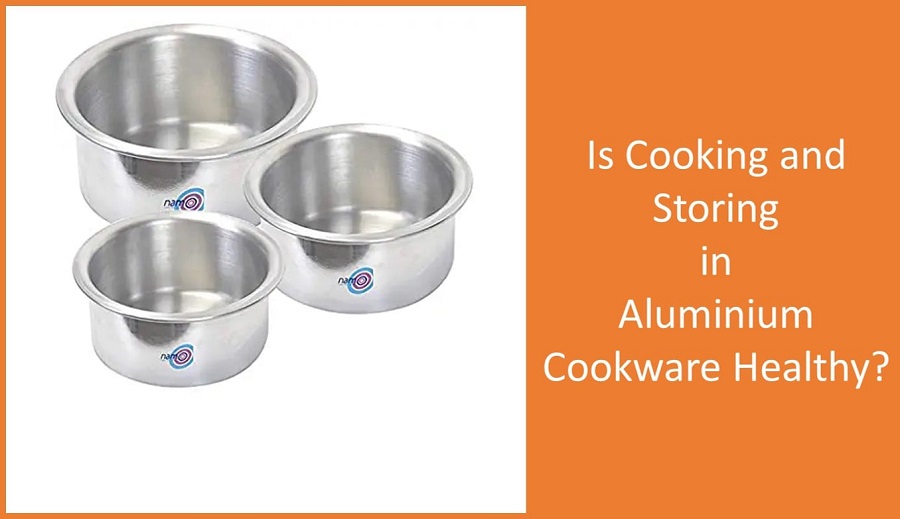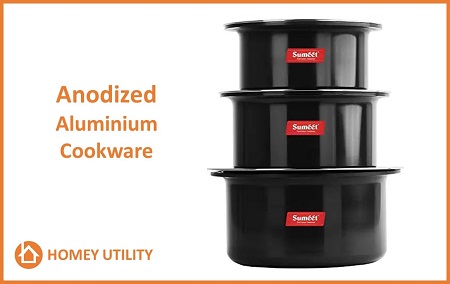
Aluminum is one of the commonly used materials for manufacturing cooking utensils. Look around you and you will find something or other made of aluminum. So, it becomes important for us to know are we doing a healthy thing?
Cooking food in Anodized Aluminium Vassals without damages or abrasions is safe.
Storing food or keeping food for a long time in cookware made from aluminum, even aluminum foil is not healthy.
Have you ever consumed roadside tea? I do almost twice daily. Have you ever noticed what pan they use?
That pan is made of aluminum. From pans to pots even tiffin and packaged foodstuff like boxes and foil contain aluminum.
That is why it is important to be aware and know about this heavy metal and our current scenarios.
Aluminium
Aluminium is a silvery-white chemical element. It is also soft and non-magnetic. It is one of the most abundant materials found on our planet.
You can find aluminium in multiple things. Cooking utensils, aluminium containers for cold drinks, some medicines and even in cosmetic materials.
So, that is why knowing about aluminium is also necessary.
How much Aluminium to consume?
As per WHO the safe upper limit for aluminum consumption for adults is 30 mg/kg body weight per day. If you see their website, you will find a LOAEL rate. The LOAEL rate is the lowest observed adverse effect level means that the maximum safe range. The LOAEL limit is 50–75 mg/kg body weight per day.
You will also see a NOAEL (no observed adverse effect level) rate. The NOAEL rate is 30 mg/kg bw per day. This is the safe limit.
| Rate | Aluminium Intake rates |
| NOAEL Rate | 30 mg/kg bw per day |
| LOAEL Rate | 50–75 mg/kg bw per day |
How much we consume?
If you look carefully, on an average aluminium pots will add 1–2mg of aluminium to our daily food intake while cooking. The numbers increase if we store food in them.
This estimation is per cooking. Now do the math. You will see below what other substances gift our aluminium.
How will you get Aluminium in your body?
Aluminium is found in multiple things that we daily use. Most of them are consumable. That is why according to WHO 90-95% of total daily intake comes from food and beverages. Some of them we all use. Here is a list of things from where you can get aluminium.
- antacids
- astringents (Not Consumable)
- buffered aspirin
- food additives
- antiperspirants(Not consumable)
- cosmetics (Not consumable)
- Cookwares.
- Foods.
- Drinking water.
Yes, foods also contain aluminium. Here is a list, which will give you some idea, how much aluminium is there in some foods.
| Food Aluminium Content | (mg/100g) | Food Aluminium Content | (mg/100g) |
| Meat, poultry, & fish | 0.02 – 0.12 | Peanut butter | 0.2 |
| Natural Cheese | 1.57 | Walnut | 0.2 |
| Processed Cheese | 29.7 | Vegetables | 0.01 – 0.44 |
| Fruits | 0.01 – 0.04 | Spinach | 2.52 |
| Wheat | 1.28 | Baking powder | 2.300 |
| White Bread, | 0.3 | Cocoa | 4.5 |
| Brown Bread | 0.54 | Pickles, with aluminium additives | 3.92 |
| Herbs & spices | 8.2 – 75.0 | Dry Tea in bag | 128 |
| Salt, with aluminium additives | 16.4 | Tea | 0.46 |
What do you think?
Do not forget, that the water that we drink also contains aluminium. I had searched the net and found an interesting research paper. This paper compares aluminium content in drinking water and tap water, in various countries. Interestingly India is one of them.
Tough the article was published in 2014. But there are no other documents giving this type of information.
Scenario in India
| Aluminium intake from Drinking water | Aluminium intake from Tap water |
| 100.75 mg | 301.93 mg |
Now, I cannot validate the information.
Well, you might be thinking about other countries in that research. So, I will also, put data from other countries as per that research.
Aluminium intake from drinking water and Tap water.
| Aluminium Intake | China | India | Egypt | Qatar |
| Drinking water | 20.16 mg | 100.75 mg | 21.39 mg | 0 mg |
| Tap water | 285.12 mg | 301.93 mg | 403.8 mg | 407.2mg |
The drinking water condition does not look good as per the research. But there are multiple things that happen. One of them is Indians buying more RO filters. I do not like RO much. I will explain in some other article. But Aluminium is a heavy metal it will help.
NALCO a government of India enterprise, renovated the water supply system in 13 villages, as a pilot project through Rural Water Supply & Sanitation (RWS & S) by spending more than 10 Cr.
They have used a Water Treatment Plant, with augmented pipeline and Nanotechnology. Their main focus was controlling fluoride. But it also has effects on Aluminium.
| Raw water | Treated Water | Tap Water. | |
| Aluminium and its compounds. | 1.7 mg/l | 0.24 mg /l | 0.14 mg/l |
| Dissolved Aluminium and its compounds. | 0.02mg/l | < 0.02 mg/l | 0.03 mg/l |
The results look promising. Right. Now let us come back to the topic.
As you can see we are consuming aluminium in multiple ways. Why add more through cookware.
So, now let us see what cookware contains aluminium.
Aluminium Cookwares.
Aluminium is one of the most abundant heavy metals on planet earth. It is also cheap. So, there are many cooking utensils that are made from aluminium.
Here is a list of cooking utensils and kitchen vassals.
| Kadhai. | Tawa. |
| Sauce Pan. | Frying Pan. |
| Tope. | Pressure Cookers. |
| Spoons. | Laddle. |
| Spinners. | Turners. |
| Nonstick Pans. | Anodized Utensils. |
| Aluminium Foil. | Aluminium Boxes. |
| Aluminium Pots. | Aluminium Containers |
Well, these are all the cookwares that are made up of aluminium. So, now how will the aluminium get from that utensil to our system.
How can cooking or storing food in Aluminium Vassals affect us?
You might be wondering how will the aluminium get into our system. If some foods are cooked in aluminium vessels or in aluminium foil and more importantly if it is stored in aluminium boxes or containers. The food will absorb some aluminium.
It is because aluminium dissolves into food and water during the cooking process. Also while storing it by the process of leaching. Leaching is the loss or extraction of materials into a liquid. To know more you can read this article on Wiki.
This absorbed aluminium will now go into the bloodstream. It will then accumulate in different organ. This accumulated heavy material that is aluminium will have adverse effects.
Are you cook food in an aluminium vessel which is not anodized and which has some abrasions, and deformities or the old utensils? Then the aluminium will start getting absorbed in your food.
Let us learn about Anodization and non-stick pans.

Anodization
In this process, the aluminium is placed in an acid solution and exposed to an electric current. A layer of aluminium oxide will get deposited on the surface of the aluminium.
It forms a hard, non- stick surface over the aluminium vassal. It makes it scratch-resistant, durable, and easy to clean.
Anodization reduces leaching of aluminium from cooking utensils into your foods, particularly acidic foods like tomatoes.
Non-stick Utensils
The non-stick material is made from Teflon. Well, it is also not healthy. I will talk about that in a different article.
Most of the nonstick pans are made of aluminium with a Teflon coating.
Now that we have seen how and from where aluminium gets into our body. Let us see what will happen if the concentration of aluminium exceeds than what is required
Aluminium Toxicity.
According to WHO, 90-95% of total daily intake comes from food and beverages. Aluminium is poorly absorbed in humans.
There is number of studies in the medical field which suggest that aluminium is neurotoxic. This means it can cause encephalopathy and dementia.
Encephalopathy is a broader term generally meaning damage, malfunction of a brain. Dementia in general terms means a decline in memory, language and other fine skills that a brain can perform. Alzheimer’s is the most common cause of dementia. But many studies say dementia due to aluminium is different from Alzheimer’s disease.
But if one has kidney diseases, then aluminium acts more adversely. Leading to larger problems.
Also Aluminium in associated with cancer. Mainly breast cancer had been studied in this regard. I also would like to make it a point the association of cancer is with topical application of aluminium like in the application of deodorants or antiperspirants.
But research suggests that the results are not that concrete. They also suggest for more detailed research.
The basic thing is that one study studied 437 breast cancer survivors. They found that they were young and frequently found using deodorants and antiperspirants. But it was not proved that it caused cancer.
That also does not mean that it did not. You can read more in the cancer.gov.
In a short if you consume more aluminium than required you will have the following problems:
- Encephalopathy.
- Dementia.
- Bone problems.
- Patients with kidney problems will have severe problems.
Safety Precautions
What are the safety precautions we should take and what should be our choices?
- Use only Anodized Aluminium utensils.
- Do not use old abraded Utensils.
- Do not use Nonstick pans, made of aluminium with a Teflon layer.
- Avoid using Aluminium foils, boxes and containers.
- Avoid cooking acidic foods in the aluminium pot. The acids leach more aluminium away. It will also alter the taste.
- Avoid storing liquids like water, milk in aluminium container.
- Use Stainless Steel, clay pots, copper pots, glass utensils, or even cast-iron utensils.
Do these things and also try tp limit drinking tea made on aluminium pots.
Conclusion
As you just saw aluminium is almost every where. We consume aluminium in multiple ways. My concern is how to control and reduce that.
If you are cooking food in an old abraded pot, then replace them with new ones. Only use anodized aluminium pots. Also never store liquids in an aluminium pot or container.